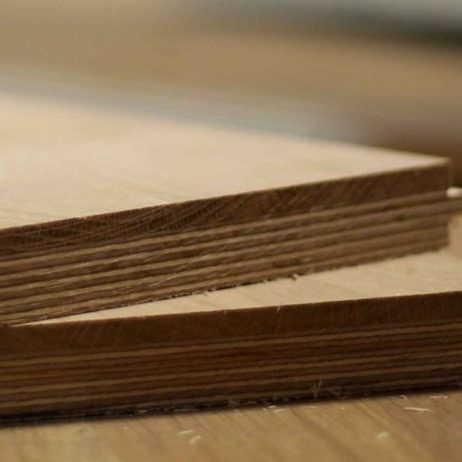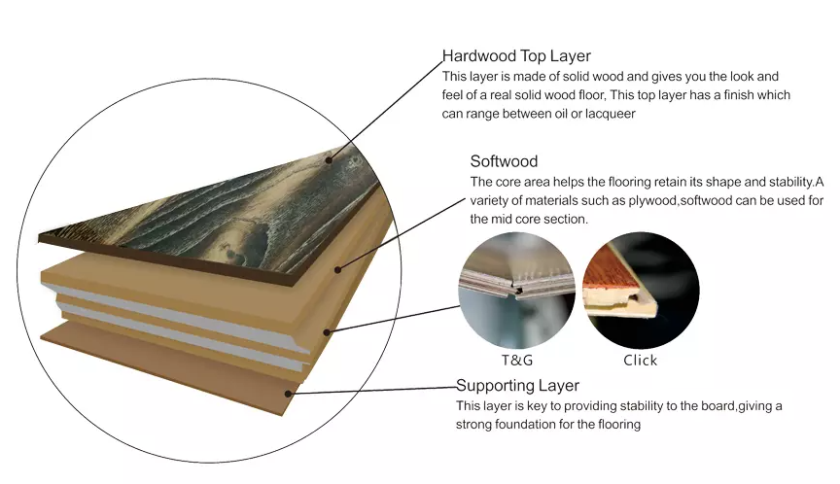

engineered wood floor (also known as composite flooring) is available in a variety of colors. It usually consists of a composite block that can look like a thick plywood covered with a thin layer of hardwood. Most composite woods are green (i.e. environmentally friendly) and consist of small, fast-growing tree fibers. This preserves old forests and uses parts of the tree that are left over after cutting hardwood panels. In this article we will explain more about the advantages of engineered wood floors and guide you through different options for composite floors.
Plywood is a collection of layers of wood that are pressed together. The same goes for engineered wood flooring. Of course with special conditions. The connection between the inner layers makes the engineered floors more durable and increases its life span. Therefore, engineered wood floors are more economical than all-wood parquets. Engineered floor consists of at least three layers and each layer is pressed together with veins perpendicular to the veins of the next layer. This layered structure, stables the surface compared to hardwoods against bending. And it increases the torsion and gives more strength to engineered parquets. How to produce engineered wood parquet wood has made it a good choice for use in various floor coverings.
The top layer is usually hardwood. This thin layer is made of wood selected by the buyer to provide both a protective surface and esthetic appeal. Of course, the choice of outer layer can range from different types of softwood to hardwood, depending on the customer’s choice.
Oak, maple and other woods commonly used in households are the most commonly used engineered wood wears. They are also among the greenest. Many of them grow fast and none of them need the energy to transport wood from abroad. Most interior woods are relatively inexpensive, softer than some exotic woods and come in a limited color spectrum; usually brown spectrum.
Brazilian cherries and other exotic hardwoods are very cheap alternatives to native woods. Some are harder and offer a wider range of colors. However, homeowners need to be careful which wood they buy. A transfer from Brazil or other countries causes considerable shipping costs.
Bamboo is actually a grass that grows very fast. All bamboo floorsings are made of enginnered wood, as bamboo cannot be chopped up on large boards. Bamboo is very environmentally friendly when harvested and harvested in a stable way, although the high transport costs of tropical bamboo forests mean that bamboo composites are less green.
Engineered wood floors have many wear layers available. All engineered floors are prefabricated and finished in the factory.
The thickness of the outer layer and the quality of the layer underneath usually show up during the warranty period. The properties of the veneer layer should be taken into account, as e.g. wear layers of engineered floor with a thickness of less than 2 mm cannot be sanded or reworked. However, if the thickness of the veneer layer is 6 mm or more, the floor can be sanded or reworked three or more times. It is proposed that engineering floors must have at least three layers, with the direction of the veins perpendicular to each other. Five layers have good stability, even if the thickness of the coating layer is not too thick.
Remember that the wear or layer is exposed to abrasion is for a beautiful appearance and the inner layer is for maximum strength and stability.
we as experts in this field recommend engineered wood because its advantages far outweigh the disadvantages.
When choosing a engineered wood floor product, consider other environmental factors as well. Look for products with low levels of unstable organic compounds that may be present in the fasteners that hold the wood floor together. Features may also be an element in the final surface of the wood or adhesives that can be used during installation.
Also look for the Forest Supervision Council (FSC) label, which means that the wood is harvested in a stable way.